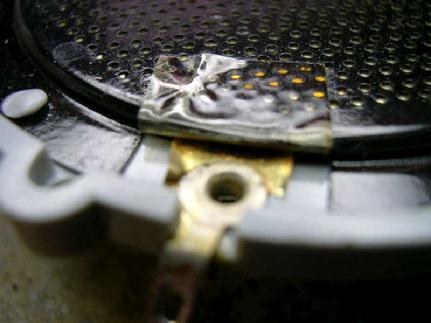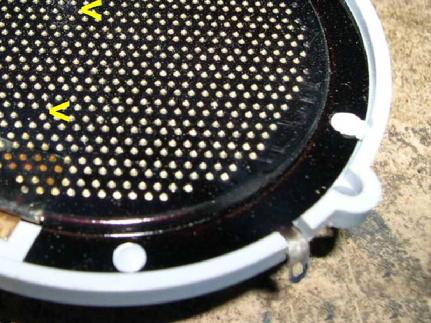| EMUD Electrostatic Tweeter Repair |
 |
| EMUD Electrostatic tweeter |
|
Electrostatic speakers are highly regarded by many audio enthusiasts for their smooth sound reproduction and extended frequency response, but they are an unusual choice in old table radios. Not only do they operate with voltages high enough to cause arcing and attract dust, they are not particularly rugged or cheap to manufacture. Yet, here I find one in an EMUD’s Rekord Junior 196, an AM/FM table radio of German manufacture from 1959. The radio’s sound is quite pleasing due in no small part to its dual speaker design that includes a 3 inch electrostatic tweeter. I was given a Rekord Junior by a friend and discovered right away its pleasant sound was ruined by an intermittent tweeter. Oh boy! Somethin’s broke and needs a fixin’!
Two wires that connect the tweeter and radio had a little over over 200 volts across them, a “polarizing voltage” essential to the electrostatic’s operation. My ‘scope showed audio signals superimposed on the voltage, which is normal, so I knew the tweeter unit itself was at fault. A little research (shoot me if I ever use a word like “googling”) taught me that failed electrostatic tweeters are common in EMUD, Telefunken, and other similar vintage designs. They apparently do not grow old very gracefully!
Since I did not have any repair experience with electrostatic tweeters, my curiosity was piqued.
|
The tweeter is surprisingly light weight. One of itsvtwo connecting wires is soldered to a contact that is riveted onto its plastic body. I saw some heat deformation around the rivet and I wondered if that deformation happened as I unsoldered the unit.
A second wire was soldered directly to a thin metal grill across the tweeter's front, which is held on by six small melted blobs. The blobs are really small pins that hold the grill in position before being melted against the grill permanently. Iíd have to break them to open the tweeter.
|
 |
| Riveted contact with Mylar strip |
|
|
 |
| Painted-over holes on front grill with solder tab |
|
|
Before breaking any of those blobs, an irreversible step, I decided to hook up the tweeter again, just to test it one more time. I hoped it would have somehow magically repaired itself so I could forget the whole thing but I was not so lucky. It had been intermittent before. Now it was completely dead. I punched the radioís am-fm selector buttons a few times, mostly out of frustration I suppose, and noticed something interesting. Each switch press produced a loud audio click and a small purple arc around the riveted contact. Cool! It wasnít supposed to do that, but then I wasnít supposed to have a cavity last month either. Anyway, little arcs were jumping from the rivet to a thin conductive Mylar strip under it. That strip leads into the tweeter (see photo). I touched a test clip between the rivet and the top of the strip, and the tweeter instantly came to life. An electrical connection between that rivet and the Mylarís conductive coating had opened up, which was apparently the tweeter's demise. Incidentally, you can see a piece of cellulose tape stuck to the grill just above the Mylar strip, apparently to prevent the possibility of a short at that point.
next page->
|
Why did loud audio clicks produce sparks? A short burst of voltage, produced as I punched the switches, traveled through the audio output amplifier into the output transformer, briefly producing a strong magnetic field. Once the burst had passed, the magnetic field collapsed, which in turn induced a rather large voltage spike into the many turns of the transformerís windings. It is the same electromagnetic process used to fire spark plugs in dad's old car. The resulting high voltage spike traveled back through circuit components onto the tweeter wires where it had enough force to jump across the tiny gap present between the rivet contact and Mylar coating. With normal audio signals the voltage buildup is fairly small and did not jump the gap, but with the right combination of pulse shape and strength, the resulting voltage spike can be large enough to jump gaps and possibly do component damage. Iíve seen failed capacitors connected across audio transformers in cheap radios, and I think this is why!
|
|
|